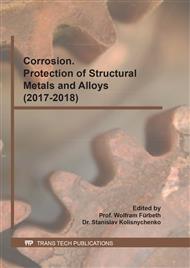[1]
Diamanti M.V., Pedeferri M.P. Effect of anodic oxidation parameters on the titanium oxides formation [J]. Corrosion Science, 2007, 49(2): 939-48.
DOI: 10.1016/j.corsci.2006.04.002
Google Scholar
[2]
Jiang Z, Dai X, Norby T, et al. Investigation of pitting resistance of titanium based on a modified point defect model [J]. Corrosion Science, 2011, 53(2): 815-21.
DOI: 10.1016/j.corsci.2010.11.015
Google Scholar
[3]
Jiang Z, Norby T, Middleton H. Evaluation of metastable pitting on titanium by charge integration of current transients [J]. Corrosion Science, 2010, 52(10): 3158-61.
DOI: 10.1016/j.corsci.2010.03.012
Google Scholar
[4]
Narayanan A.R., Seshadri S.K. Phosphoric acid anodization of Ti-6Al-4V Structural and corrosion aspects [J]. Corrosion Science, 2007, 49(2): 542-58.
DOI: 10.1016/j.corsci.2006.06.021
Google Scholar
[5]
Fu T.L., Zhan Z.l., Zhang L, et al. Effect of surface mechanical attrition treatment on corrosion resistance of commercial pure titanium [J]. Surface & Coatings Technology, 2015, 280(129-35.
DOI: 10.1016/j.surfcoat.2015.08.041
Google Scholar
[6]
Ningshen S, Mudali U.K., Ramya S, et al. Corrosion behaviour of AISI type 304L stainless steel in nitric acid media containing oxidizing species [J]. Corrosion Science, 2011, 53(1): 64-70.
DOI: 10.1016/j.corsci.2010.09.023
Google Scholar
[7]
Avelar-Batista J.C., Spain E, Housden J, et al. Plasma nitriding of Ti6Al4V alloy and AISI M2 steel substrates using D.C. glow discharges under a triode configuration [J]. Surface & Coatings Technology, 2005, 200(5): 1954-61.
DOI: 10.1016/j.surfcoat.2005.08.037
Google Scholar
[8]
Robin A, Meirelis J.P. Influence of fluoride concentration and pH on corrosion behavior of Ti-6Al-4V and Ti-23Ta alloys in artificial saliva [J]. Materials & Corrosion, 2015, 58(3): 173-80.
DOI: 10.1002/maco.200604004
Google Scholar
[9]
Krawiec H, Vignal V, Schwarzenboeck E, et al. Role of plastic deformation and microstructure in the micro-electrochemical behaviour of Ti-6Al-4V in sodium chloride solution [J]. Electrochimica Acta, 2013, 104(8): 400-6.
DOI: 10.1016/j.electacta.2012.12.029
Google Scholar
[10]
Wang Z.B., Hu H.X., Zheng Y.G., et al. Comparison of the corrosion behavior of pure titanium and its alloys in fluoride-containing sulfuric acid [J]. Corrosion Science, 2016, 103: 50-65.
DOI: 10.1016/j.corsci.2015.11.003
Google Scholar
[11]
Leiva-Garc A.R., Fernandes J.C.S., Mu Oz-Portero M.J., et al. Study of the sensitisation process of a duplex stainless steel (UNS 1.4462) by means of confocal microscopy and localised electrochemical techniques [J]. Corrosion Science, 2015, 94: 327-41.
DOI: 10.1016/j.corsci.2015.02.016
Google Scholar
[12]
Belo M.D.C., Hakiki N.E., Ferreira M.G.S. Semiconducting properties of passive films formed on nickel-base alloys type Alloy 600: influence of the alloying elements [J]. Electrochimica Acta, 1999, 44(14): 2473-81.
DOI: 10.1016/s0013-4686(98)00372-7
Google Scholar



